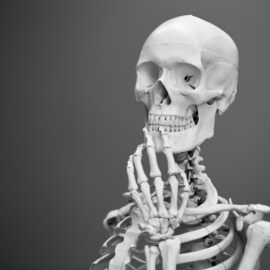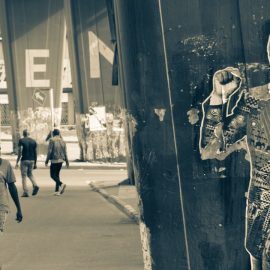

This article is an excerpt from the Shortform book guide to "American Prometheus" by Kai Bird and Martin Sherwin. Shortform has the world's best summaries and analyses of books you should be reading.
Like this article? Sign up for a free trial here.
Why did J. Robert Oppenheimer almost get kicked out of Cambridge? Was he a communist? How did the attack on Pearl Harbor change his focus and, ultimately, his life?
Biographers Kai Bird and Martin Sherwin aren’t content to talk only about J. Robert Oppenheimer’s work on the Manhattan Project. They also discuss his struggles with mental illness in his youth, his education and career launch, and his political activism that led to allegations of Communist Party membership.
Keep reading to learn about Oppenheimer’s early life, including the preface to his involvement in the development of the atom bomb.
Oppenheimer’s Early Life
Though most historical accounts focus on Oppenheimer’s work on the atomic bomb, Bird and Sherwin suggest that Oppenheimer’s early life provides context for understanding his views and decisions later in life. They argue that Oppenheimer’s adolescent years were marked by emotional instability that eventually gave way to committed left-wing political activism.
Adolescent Emotional Instability
According to Bird and Sherwin, Oppenheimer’s adolescence and early adulthood were marked by severe emotional instability. Specifically, they contend that Oppenheimer suffered from chronic depression and emotional breakdowns, only to recover in his mid-20s.
They note that, according to Oppenheimer’s friend and Harvard University classmate Paul Horgan, Oppenheimer was prone to multiday depressive episodes at Harvard. During these episodes, he became increasingly reclusive and unavailable to even his closest friends. This emotional volatility, Bird and Sherwin argue, grew even worse during Oppenheimer’s graduate studies at the University of Cambridge in 1925. While there, Oppenheimer allegedly attempted to poison his tutor, whom he was upset with, by leaving a poisoned apple on his desk—an allegation that would nearly result in Oppenheimer’s expulsion from Cambridge.
As Bird and Sherwin relate, Oppenheimer was allowed to remain a student at Cambridge on the condition that he undergo psychoanalysis (a form of therapy that seeks to uncover and address the unconscious roots of our behavior). However, although Oppenheimer was diagnosed with dementia praecox—what’s now known as schizophrenia—the psychoanalysis proved unhelpful. Instead, Bird and Sherwin write, Oppenheimer cited existentialist literature and its emphasis on introspection as the catalyst for improving his mental health.
Oppenheimer’s Early Success in Theoretical Physics
Bird and Sherwin write that, after Oppenheimer’s mental health improved, he enjoyed great success while studying theoretical physics. First, Oppenheimer moved to The University of Göttingen to study with the eminent physicist Max Born, who supervised his doctoral dissertation. There, Oppenheimer published influential work on the burgeoning field of quantum mechanics—he even copublished a paper with Born on the “Born-Oppenheimer approximation,” deemed a key development in quantum mechanics.
(Shortform note: Oppenheimer’s experience studying theoretical physics in the late 1920s was part of a broader trend in the US toward scientific achievement. In particular, experts argue that the early 1900s saw a dramatic rise in funding and physics students in the US, which had previously lagged behind Europe in most major scientific fields. In turn, universities could hire more faculty in specialty areas, like quantum physics, which helped quantum physics become a mainstay of US science departments.)
Later, in 1928 Oppenheimer accepted a professorship at the University of California, Berkeley, where he spent the next decade turning Berkeley into America’s foremost theoretical physics powerhouse. He continued publishing crucial work in theoretical physics, even mathematically predicting the existence of black holes in a coauthored paper in 1939.
(Shortform note: Oppenheimer’s work promoting Berkeley’s physics department has paid dividends nearly a century later—as of 2023, the US News and World Report ranked Berkeley the third-best physics program in the country, and other global rankings have placed Berkeley’s theoretical physics program in particular among the top 10 in the world.)
Early Political Views and Activism
As Oppenheimer began his academic career, he became increasingly politically active—a development foreshadowed by his membership in the Student Liberal Club at Harvard in 1922. As Bird and Sherwin argue, Oppenheimer consistently supported progressive causes throughout the 1930s, a fact that contributed to accusations of Communist activities (accusations that haunted him later in life).
Bird and Sherwin note that, owing to economic turmoil following the Great Depression, dockworkers in Berkeley, California—Oppenheimer’s home at the time—started an 83-day strike that upended California’s economy. To show his support, Oppenheimer and his students attended left-wing rallies that celebrated the striking dockworkers. This development, Bird and Sherwin suggest, foreshadowed Oppenheimer’s later support for unions: He became an active member of the East Bay Teachers’ Union in the late 1930s, one of the few Berkeley academics to do so.
In addition to supporting workers’ rights, Oppenheimer became an active champion of the Spanish Republic—the democratically elected Republican Government that was under attack from fascist militants. According to Bird and Sherwin, Oppenheimer was documented as donating about $1,000 annually (around $20,000 in today’s money) in the late 1930s to the Spanish Republican cause. Crucially, Oppenheimer donated this money via Communist Party chapters in America because the Communist Party was directly assisting the Spanish Republic.
Alleged Communist Party Membership
Because Oppenheimer worked closely with members of the Communist Party, many of his detractors alleged he was a Communist Party member himself. Against this allegation, Bird and Sherwin contend that although Oppenheimer’s political views often aligned with Communist Party views, he was never a formal member.
In defense of this claim, Bird and Sherwin cite interviews with several Communist Party members that Oppenheimer had befriended—these friends reported that, although Oppenheimer often socialized with Communist Party members, he never paid dues to those in charge of Party finances, which members were required to do. Even more importantly, these friends claimed Oppenheimer was never subject to Party discipline, which would have required him to stop reading many of his favorite intellectuals, such as Freud and Hemingway.
Nonetheless, Bird and Sherwin acknowledge that certain Party members, like Oppenheimer’s friend and fellow Berkeley professor Haakon Chevalier, believed Oppenheimer was a Party member, citing his regular visits to Party meetings and his support of progressive political causes. Others pointed to Oppenheimer’s intimate relationships with Party members—Oppenheimer had a relationship with Jean Tatlock, a committed Party member, between 1936 and 1939, and his wife Kitty was a former Party member herself. But Bird and Sherwin argue these friends were likely mistaken by Oppenheimer’s close proximity to the Party, which is distinct from Party membership.
The Invitation to Join the Manhattan Project
Bird and Sherwin contend that Oppenheimer’s interest in a broad range of progressive causes, from labor unions to the Spanish revolution, was upended by one event: Japan’s bombing of Pearl Harbor in December 1941. Rather than continue investing in these causes, Oppenheimer shifted his focus singularly toward the impending war with Germany and the other Axis powers (Japan and Italy).
(Shortform note: Oppenheimer’s response to the bombing of Pearl Harbor was shared by the vast majority of Americans. Indeed, experts argue that Pearl Harbor was a uniquely unifying moment in American history, as it united Americans against a common enemy that threatened to destroy the US altogether. For this reason, the Senate even voted unanimously to declare War against Japan, a rare act of consensus across party lines.)
The US government was initially reluctant to include Oppenheimer in the bomb project because of his past political associations. However, in 1941 Oppenheimer’s colleague at Berkeley, the renowned experimental physicist Ernest Lawrence, vouched for Oppenheimer and earned him an invite to early government meetings about the bomb. Then, in 1942 the government’s committee on nuclear weapons made Oppenheimer the leader of fast-neutron research, a key component of developing the atomic bomb. Having shown his worth, Oppenheimer was nominated by General Leslie Groves to direct the Manhattan Project (the US’s nuclear weapons project) in October 1942.

———End of Preview———
Like what you just read? Read the rest of the world's best book summary and analysis of Kai Bird and Martin Sherwin's "American Prometheus" at Shortform.
Here's what you'll find in our full American Prometheus summary:
- The biography of J. Robert Oppenheimer that inspired the movie Oppenheimer
- Oppenheimer's early life and mental health struggles
- Oppenheimer's role in developing the atomic bomb and the following hearing






